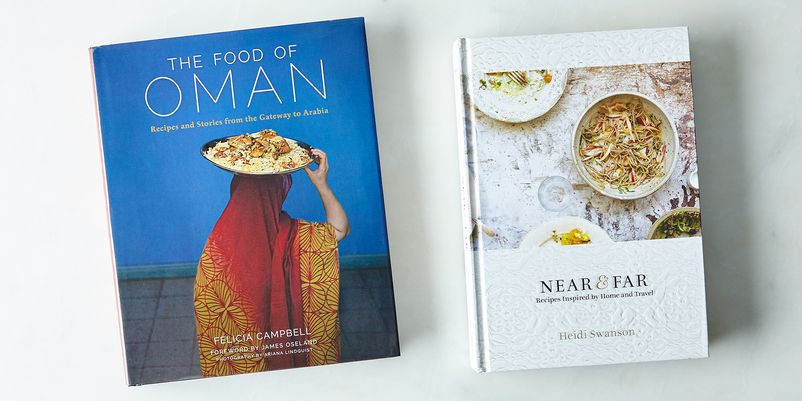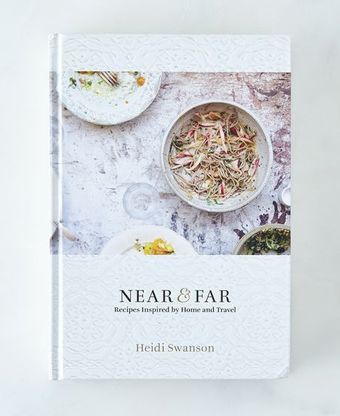“Travel cookbooks,” I thought, when my two Piglet books arrived. And they are, in a sense: Both Near & Far and The Food of Oman seek to make the foreign domestic, both seek to bring the exotic home.
I enjoy culinary travelogues; like many of us, I nibble my way through vacations and note new flavor combinations as I encounter them. Look to the Sqirl menu and you’ll find evidence of many of these discovered tastes.
In Near & Far: Recipes Inspired by Home and Travel, Heidi Swanson gives us 35 dishes and drinks from her home kitchen in San Francisco (the “Near”), and 70 recipes inspired by her travels to India, France, Italy, Japan, and Morocco (the “Far”). In between, you’ll find short essays about each country, Instagram-worthy snaps of the author abroad, and, on page 96, a list of Swanson’s current immunizations. All the dishes are vegetarian. And all photograph exceptionally well, which is no surprise given Swanson’s prior works (see, for example, the James Beard Award-winning Super Natural Every Day).
Her recipes are mostly interpretations—not reproductions—of foreign dishes. And Swanson tell us this up front: “These are recipes inspired by ingredients I’ve encountered, markets I’ve shopped, cooks I’ve chatted up, books I’ve read, and scribbles I’ve made in my journal.” This is world cuisine as seen through Swanson’s eyes: natural, healthy, clean, simple. So we find dishes like Brussels Sprouts with Japanese Mustard and Nori Granola in the Japan section, though we are unlikely to find them in Japan.
Her recipes rely less on technique and kitchen wizardry, and more on simplicity and brightness through clean cooking. Swanson’s Vaghareli Makai (Indian spiced corn) is an original take on a corn side—it tasted new in comparison to the lime and Aleppo-scented corn from Thomas Keller’s Ad Hoc I find myself cooking on repeat.
I also made Swanson’s Sprout & Yogurt Salad; Sqirl’s book, Everything I Want To Eat, comes out this fall and has a few sprout recipes peppered throughout, so I was curious to see her direction. The recipe went off without a hitch: It was fresh and easy, with no fluff, and totally delicious—perfect for starter cooks and seasoned ones alike. And that is the worthy goal at this book’s heart: to bring the best of what’s out there home to everyone in one accessible, convenient volume. It is Super Natural Every Day: A Moveable Feast.
Then there's The Food of Oman: Recipes and Stories from the Gateway to Arabia, a paean to the country’s spice-laden souks, ancient ports, and golden dunes. Our tour guide is Felicia Campbell, and what impressive credentials she has. Campbell enlisted in the Army at 17 and was deployed to Iraq at 19; there, she fell in love with the smells, flavors, and cultural traditions of Middle Eastern cuisine. And she missed them when she returned to the States, so she earned a master’s degree in food studies, became a journalist, toured the region, and now splits her time between Manhattan and Muscat, Oman’s capital city.
Campbell tells us that Oman is “not merely a place; it is an immersive, sensory experience.” That’s true of the book as a whole, too: It’s immersive, packed full of sociological observations, historical vignettes, and meditations on Oman’s national identity.
And it’s sensory. Once you start cooking and eating, you quickly realize that Omani food is a complicated culinary kaleidoscope of flavors, ingredients, and traditions—it is at once Arabic and Indian, Levantine and Bedouin. Its depth and diversity reflect the sultanate’s long history as a global commercial and cultural hub, one that straddles well-worn spice and trade routes. And so we find a desert-meets-the-sea mashup of grilled, nomadic campfire fare, platefuls of flavorful and fluffy biryani, and familiar, but “Omanified,” subcontinental staples: dals and flatbreads, curries and savory porridges, spiced teas and pungent chutneys. Campbell’s Maldouf (date chapati) was delicious, and a concept I’ll continue to play with; I can’t wait to put dates in Lafa breads here in LA. Her Yemeni-style roast chicken (Mandi Djaj) was appealing and clearly-written, if a little basic in flavor. But Campbell’s effort to make sense of this gastronomical diversity is an ambitious and delicious success.
These are very different books for very different audiences, but I’ve been told that this is a competition. And the editors at Food52 demand that I make a choice, so I will choose!
Campbell’s impressive and inspiring work—masterfully complemented with Ariana Lindquist’s photography—will remain on my bookshelf forever. Between the two, it is the book into which I'll dive the deepest and from which I will draw the most inspiration. The recipes from her book may require an extensive number of steps, but the results are vibrant. Her Omani Chicken and Rice Porridge (Madrouba) is such a standout that we adopted and adapted a version of it for our own restaurant… Thank you, Felicia!
Aesthetically, I found Near & Far to be truer to the author’s voice and purpose than The Food of Oman. Design matters, especially when one is attempting to capture and convey the spirit of an exotic locale or cuisine. Campbell’s writing and Lindquist’s photography are excellent, but it doesn’t seem as though they had similar control of the book’s design and layout. This is the biggest contrast between the two books.
In the end, it’s Swanson’s Near & Far that I’ve decided to advance. Here’s why: Campbell’s book may be more compelling to my own cooking and work at Sqirl, but Swanson’s simple recipes are more approachable—they make Near & Far a better fit for cooks of all skill levels. When I shared these books with my friends and family, they spent more time paging through Near & Far than The Food of Oman. Most wanted to cook Swanson’s food. That night. For dinner. Near & Far’s “nearness,” combined with its polished and professional look, give Swanson’s book an edge—albeit ever so slight—over Campbell’s Omani opus.



16 Comments
The thing that surprised me most about Near & Far, BTW, was that even though it wasn't the selling point, most of the recipes are really really good for you, without being smug. It just made healthy cooking feel a lot more fresh and fun in a very nonchalant way.
I like the analysis made of The Food of Oman. It seems like an original book more useful to discover a culture and a country, than to cook everyday meals.